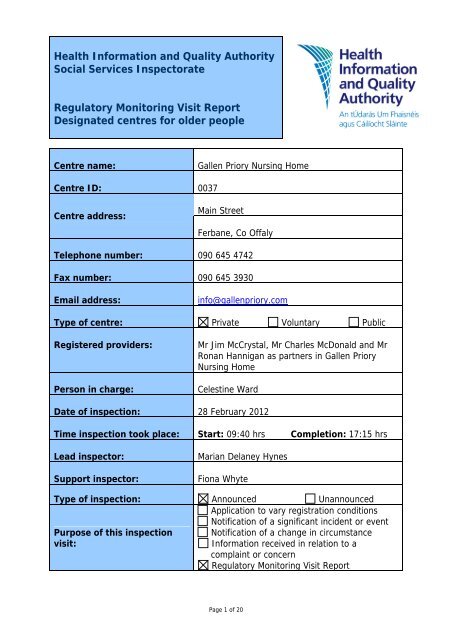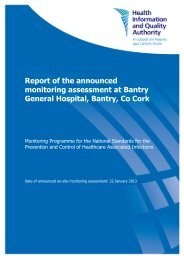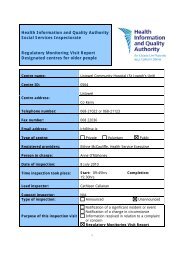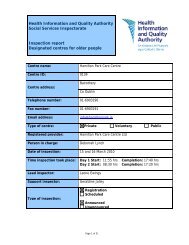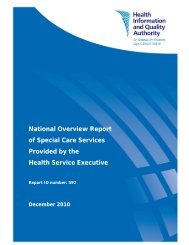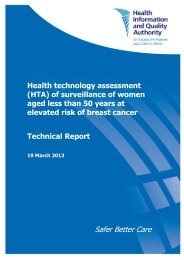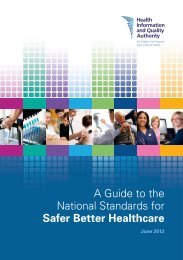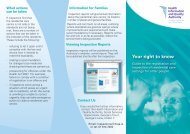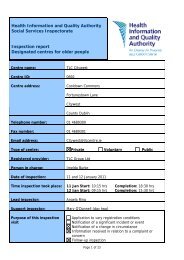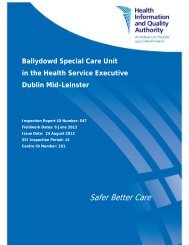Gallen Priory Nursing Home, 37, inspection report 28 - hiqa.ie
Gallen Priory Nursing Home, 37, inspection report 28 - hiqa.ie
Gallen Priory Nursing Home, 37, inspection report 28 - hiqa.ie
You also want an ePaper? Increase the reach of your titles
YUMPU automatically turns print PDFs into web optimized ePapers that Google loves.
About the <strong>inspection</strong>The purpose of <strong>inspection</strong> is to gather evidence on which to make judgments aboutthe fitness of the registered provider and to <strong>report</strong> on the quality of the service. Thisis to ensure that providers are complying with the requirements and conditions oftheir registration and meet the Standards, that they have systems in place to bothsafeguard the welfare of service users and to provide information and evidence ofgood and poor practice.In assessing the overall quality of the service provided, inspectors examine how wellthe provider has met the requirements of the Health Act 2007, the Health Act 2007(Care and Welfare of Residents in Designated Centres for Older People) Regulations2009 (as amended) and the National Quality Standards for Residential Care Settingsfor Older People in Ireland.Additional <strong>inspection</strong>s take place under the following circumstances:• to follow up on specific matters arising from a previous <strong>inspection</strong> to ensurethat the action required of the provider has been taken• following a change in circumstances; for example, following a notification tothe Health Information and Quality Authority’s Social Services Inspectoratethat a provider has appointed a new person in charge• arising from a number of events including information received in relation to aconcern/complaint or notification to the SSI of a significant event affecting thesafety or wellbeing of residents• for centres that have not previously been inspected within a specifictimeframe, a one-day regulatory monitoring visit may be carr<strong>ie</strong>d out to focuson key regulatory requirements.All <strong>inspection</strong>s can be announced or unannounced, depending on the reason for the<strong>inspection</strong> and may take place at any time of day or night.All <strong>inspection</strong> <strong>report</strong>s produced by the Health Information and Quality Authority willbe published. However, in cases where legal or enforcement activity may arise fromthe findings of an <strong>inspection</strong>, the publication of a <strong>report</strong> will be delayed until thatactivity is resolved. The reason for this is that the publication of a <strong>report</strong> mayprejudice any proceedings by putting evidence into the public domain.Page 2 of 20
Management structureThe Provider is a partnership and Jim McCrystal is the nominated person to act onbehalf of the Provider. Celestine Ward is the Person in Charge. The staff nurses,activit<strong>ie</strong>s coordinator, administration staff, chef, catering, laundry and cleaning staffall <strong>report</strong> to the Person in Charge. The care assistants <strong>report</strong> to the nurses.StaffdesignationNumber ofstaff ondutyon dayof<strong>inspection</strong>PersoninChargeNursesCarestaffCateringstaffCleaningandlaundrystaff1 3 9 2 2 cleaning1 laundryAdminstaff2 *1Otherstaff* The provider was in attendance during the <strong>inspection</strong>.Summary of findings from this <strong>inspection</strong><strong>Gallen</strong> <strong>Priory</strong> <strong>Nursing</strong> <strong>Home</strong> was inspected six times by the Authority. The first<strong>inspection</strong> was carr<strong>ie</strong>d out on 17 and 18 August 2009 followed by <strong>inspection</strong>s on 9September 2009 and 12 Jan 2010. A registration <strong>inspection</strong> was carr<strong>ie</strong>d out on 10and 11 March 2011 followed by <strong>inspection</strong>s on 14 December 2010 and 16 and 22March 2011.The <strong>inspection</strong>s <strong>report</strong>s are available on www.<strong>hiqa</strong>.<strong>ie</strong> under centrenumber 00<strong>37</strong>.This was an announced monitoring <strong>inspection</strong> and the seventh <strong>inspection</strong> carr<strong>ie</strong>d outby the Authority. This <strong>inspection</strong> incorporated a fit-person interv<strong>ie</strong>w with the recentlyappointed person in charge.Overall inspectors were satisf<strong>ie</strong>d that <strong>Gallen</strong> <strong>Priory</strong> was well-run and there wasevidence that the actions from previous <strong>inspection</strong>s were addressed. The providerand person in charge were committed to providing a high level of care to residentsand promoted the safety of residents whilst ensuring they live as independently aspossible. Staff were knowledgeable about fire safety and the prevention andresponse to allegations of elder abuse. Although there was evidence that the healthand social needs of residents were met some care plans were not suffic<strong>ie</strong>ntlyupdated to reflect the current care status of residents.The quality of residents’ lives was enhanced by the provision of activit<strong>ie</strong>s andopportunit<strong>ie</strong>s appropriate to their assessed needs. There were however additionalimprovements required in risk management, fire safety records, moving and handlingtraining and hot water supply. These areas for improvement are discussed further inthe <strong>report</strong> and are included in the Action Plan at the end of the <strong>report</strong>.Page 4 of 20
Comments by residents and relativesInspectors met with several residents throughout the day. All of the feedbackreceived was positive and several spoke of the commitment of the person in chargeand the kindness she displayed to residents. Residents said that they felt safe andthat if they had a concern, they could speak to the person in charge or any staffmember. They said that they had opportunit<strong>ie</strong>s to engage in meaningful activit<strong>ie</strong>s.One resident showed the inspectors her recently completed Valentines paintingwhich was displayed in the dining room.All residents spoken to said they enjoyed their food and were complimentary aboutthe staff. Residents said they were very satisf<strong>ie</strong>d with the level of care they received.They complimented the staff for their courtesy and willingness to assist them.Discussions with residents indicated that mealtimes particularly breakfast times andbedtime routines were flexible.Page 5 of 20
Article 16: StaffingThere were appropriate staff numbers and skill-mix to meet the assessed needs ofresidents. Staff rotas rev<strong>ie</strong>wed by inspectors indicated that these were the usualarrangements. The staff rota detailed each staff member’s position and full name. Aregistered nurse was on-duty at all times including night duty. When questionedduring the fit-person interv<strong>ie</strong>w the person in charge told inspectors that she did notcomplete the staff roster, this was completed by the provider. Therefore thedependency levels and assessed needs of the residents did not inform theformulation of the roster. The person in charge stated that the roster would bealtered on a day-to-day basis if additional staff were identif<strong>ie</strong>d as being required.There was a robust written operational recruitment policy in place and staff wererecruited in accordance with the policy. Inspectors examined a sample of staff files.All staff files contained the information required by the Regulations.Staff informed inspectors that cop<strong>ie</strong>s of both the Regulations and the Standards hadbeen made available to them and they expressed an adequate knowledge of theircontent.The management structure and <strong>report</strong>ing relationships were clearly understood bystaff. Staff were clear about their roles and responsibilit<strong>ie</strong>s and were able to explainthese to inspectors.Article 23: Directory of ResidentsInspectors rev<strong>ie</strong>wed the directory of residents and found that it met therequirements of the Regulations and included the details of a recent transfer to theacute hospital.Article 31: Risk Management ProceduresInspectors found that practice in relation to the health and safety of residents andthe management of risk generally promoted the safety of residents, staff and visitorshowever some improvements were identif<strong>ie</strong>d.There was a visitors’ sign-in book located at the entrance to the centre. This allowedthe staff to monitor the movement of persons in and out of the building to ensurethe safety and security of residents. Inspectors observed visitors’ daily signatures inthe visitor’s book.There were two emergenc<strong>ie</strong>s plans in place. One dealt with major emergenc<strong>ie</strong>s suchas explosion, air crash and armed robbery while the second provided guidance onthe day-to-day emergenc<strong>ie</strong>s that may occur such as water disruption and poweroutage. Some of the information provided on managing emergenc<strong>ie</strong>s such as poweroutage was basic and did not provide clear guidance to staff in the event of specificemergenc<strong>ie</strong>s. Inspectors also found that the emergency plan identif<strong>ie</strong>d wherePage 7 of 20
esidents would be transferred to it in the event of evacuation but was not specificregarding how residents would be transported to the location.There was a health and safety statement, a safety policy and a risk managementpolicy in place. The risk management policy addressed the risks identif<strong>ie</strong>d in theRegulations such as self harm and residents going missing. Each policy containedvarious risk assessments but because the risk assessments were spread over threepolic<strong>ie</strong>s it made the information difficult to locate and access. They did not highlightall of the risks and potential risks in the units. For example, there were no riskassessments completed for residents using the smoking area or the laundry facilit<strong>ie</strong>sand it did not provide guidance in the case of accidental needle stick injur<strong>ie</strong>s toresidents and staff.Inspectors rev<strong>ie</strong>wed the incidents and near misses and found that there were arelatively low number of falls during the previous months. There was an adequatesystem in place for the identification, recording, investigation and learning fromserious or untoward incidents or adverse events involving residents. Incident formswere completed for each incident, residents were assessed following a fall and theperson in charge said she discussed this at the handover <strong>report</strong> with staff.Article 39: Complaints ProceduresDuring the fit person interv<strong>ie</strong>w the person in charge demonstrated a positive attitudetowards complaints and v<strong>ie</strong>wed complaints as a useful means to improve the service.The complaints procedure was displayed in a user fr<strong>ie</strong>ndly format at the entranceand described in the Residents’ Guide and the statement of purpose. The person incharge was identif<strong>ie</strong>d as the named complaints officer. She described her role indetail and produced a complaints’ log for inspectors to rev<strong>ie</strong>w. The log containedrecords of complaints, including all relevant information about the complaint,investigation and the outcome.Staff members were knowledgeable about the policy and their role in responding toissues identif<strong>ie</strong>d by residents so that they did not escalate and become the subjectfor a complaint. The complaints policy contained an independent appeals process.Article 36: Notification of IncidentsPractice in relation to notifications of incidents was satisfactory.The person in charge was aware of the legal requirement to notify the Ch<strong>ie</strong>fInspector regarding incidents and accidents. To date all relevant incidents had beennotif<strong>ie</strong>d to the Ch<strong>ie</strong>f Inspector by the person in charge.Page 8 of 20
Resident CareArticle 9: Health CareInspectors were satisf<strong>ie</strong>d that the healthcare needs of residents were met. Theyrev<strong>ie</strong>wed residents care plans and noted that while overall the documentation was ofa good standard some improvements were required.Resident’s physical and mental health was promoted through the provision of socialcontact and appropriate health promoting interventions such as a healthy d<strong>ie</strong>t,regular monitoring of weight, pulse and blood pressure and opportunit<strong>ie</strong>s for exerciseand meaningful engagement. Inspectors rev<strong>ie</strong>wed a selection of residents’ files whichshowed that pre-admission assessments were completed by the person in charge toensure the needs of the potential resident could be met. The person in charge toldinspectors how she went to the hospital or to the home to meet prospectiveresidents to ensure the service could meet with their needs.Some care plans rev<strong>ie</strong>wed had not been updated to reflect the current care needs ofresidents. For example the care plan of one resident with a wound stated that thewound contained Methycillin Resistant Staphylococcus Aureus (MRSA), however thenurse said that this was now resolved but that the care plan had not been updatedto reflect the residents current status. The daily notes of another resident indicatedthat he was exper<strong>ie</strong>ncing regular pain, although analgesia had been prescribed itappeared not to be effective. A pain assessment had not been undertaken and therewas no care plan in place.Inspectors found that there was good access to medical practitioners in the localarea and there was evidence that residents were regularly rev<strong>ie</strong>wed by their generalpractitioner (GP). In addition to GP services, there was evidence that residents hadgood access to psychiatry of later life services, occupational therapy (OT),physiotherapy, speech and language therapy (SALT), d<strong>ie</strong>tetics, dental and opticianservices where necessary. Records of referrals and recommendations weremaintained on the residents’ medical files.Inspectors saw documentary evidence to demonstrate that residents’ weights wererecorded each month and the nursing staff monitored any changes such assignificant weight loss. Nutritional risk assessments were used to identify residents atrisk and there were care plans developed for these residents.Inspectors found that a number of clinical risk assessments were completed, andcare plans developed for residents with high risk of falling. Preventative strateg<strong>ie</strong>swere in place such as increased supervision and the use of low beds and or crashmats. Residents who were at risk of pressure ulcer development had been providedwith pressure rel<strong>ie</strong>ving devices such as mattresses and cushions.Inspectors noted that there were a small number of residents using bedrails at nighttime; records showed that this was at the request of individual residents. InspectorsPage 9 of 20
ev<strong>ie</strong>wed files for a sample of these residents and found that there was anassessment completed for the use of the restraint. There was evidence thatalternative strateg<strong>ie</strong>s had been tr<strong>ie</strong>d prior to the use of restraint in line with thecentres policy and the national guidelines on the use of restraint. Records weremaintained documenting the release of the restraint.There were opportunit<strong>ie</strong>s for each resident to participate in activit<strong>ie</strong>s appropriate tohis or her interests and capacit<strong>ie</strong>s. The inspector met with the activit<strong>ie</strong>s coordinatorresponsible for activit<strong>ie</strong>s on that day. A social care assessment had been completedin respect of each resident and this information was used to develop activity careplans. There was evidence that residents engaged in activit<strong>ie</strong>s such as painting,exercises, and music, crafts, reading and current affairs. A schedule was developedby the activity coordinator and she told inspectors this was rev<strong>ie</strong>wed and changed toaccommodate resident’s wishes on a day-to-day basis.Article 33: Ordering, Prescribing, Storing and Administration of MedicinesInspectors found evidence of good medication management processes. There werecomprehensive medication management polic<strong>ie</strong>s which provided guidance to staff.Inspectors observed the nurses on part of their medication rounds and found thatmedication was administered in accordance with the policy and An Bord Altranaisguidelines. All medications no longer used were signed as discontinued by themedical practitioner. Some residents had as required (PRN) medication prescribedand the maximum dose in 24-hours was recorded on the prescription sheet.Medications that required special control measures were carefully managed and keptin a secure cabinet in keeping with the Misuse of Drugs (Safe Custody) Regulations,1982. Nurses kept a register of controlled drugs. Two nurses signed and dated theregister at the time of administration and the stock balance was checked and signedby two nurses at the change of each shift. Inspectors checked the balances andfound them to be correct.A medication fridge was in place and inspectors noted that it was kept in a lockedroom and the daily temperatures were recorded. There were appropriate proceduresfor the handling and disposal of unused and out-of-date medicines. Inspectors alsonoted that there was regular input from the pharmacist who audited drug stocks andmedication management practices and provided regular updates for staff.The person in charge maintained records of medication errors and used these toimprove the service with the pharmacy. The GP rev<strong>ie</strong>wed every resident’s medicationthree-monthly and these records were rev<strong>ie</strong>wed by inspectors.Page 10 of 20
Article 6: General Welfare and ProtectionInspectors found that there were specific arrangements in place to protect residentsfrom being harmed or suffering abuse and the person in charge, proactively soughtfeedback on issues of concern from residents and relatives. Some improvementswere identif<strong>ie</strong>d in the provision of mandatory training to staff.There was a policy on and procedures in place for the prevention, detection andresponse to abuse. During the fit-person interv<strong>ie</strong>w the person in chargecomprehensively detailed how she would investigate an allegation of abuse.Training records showed that all staff had formal elder abuse training, had access tothe policy and were knowledgeable about types of abuse and how to respond to anallegation of abuse. Residents spoken to confirmed to inspectors that they felt safe inthe centre. The Authority has received no notifications of any allegation, suspectedor confirmed abuse of any resident.Good moving and handling practices were observed throughout the <strong>inspection</strong>however, the records showed that three staff members had not attended moving andhandling training. Inspectors observed that staff ensured the safety of the moredependent residents by using gait belts when supporting them to mobilise incommunal areas.Measures were in place to prevent accidents and facilitate residents’ mobility,including non-slip floor covering in bathrooms and toilets and hand rails which wereprovided in communal areas to promote independence. Residents were observedmoving around the building during the day using the handrails for support.Article 20: Food and NutritionInspectors were satisf<strong>ie</strong>d that residents received a nutritious and var<strong>ie</strong>d d<strong>ie</strong>t thatoffered choice. Mealtimes were unhurr<strong>ie</strong>d social occasions that providedopportunit<strong>ie</strong>s for residents to interact with each other and with staff.Inspectors saw that residents were offered a var<strong>ie</strong>ty of snacks and drinks throughoutthe day. Jugs with a var<strong>ie</strong>ty of juices and water were available in common areas andstaff offered drinks to residents on an hourly basis which was recorded in respect ofeach resident.Inspectors observed residents having their midday meal in a bright, relaxedenvironment. Residents said that they enjoyed the food and showed the inspectorsthe menu outlining the choices available.Inspectors saw that residents who needed their food served in an altered consistencysuch as pureed had the same menu options as others and the food was presented inappetising individual portions. Some residents required assistance with their mealand this was provided in a discreet and respectful manner.The mealtime was a relaxed and enjoyable exper<strong>ie</strong>nce for residents. It was served intwo dining rooms, one on the ground floor and another on the first floor. FoodPage 11 of 20
menus were displayed in both areas. The menus contained pictures of the mealoptions and the chef was satisf<strong>ie</strong>d that she had made every effort to inform residentsof the menu, particularly those who had a cognitive impairment. The chef had alsoconsulted with each resident individually regarding choice, var<strong>ie</strong>ty and preferredportion size. Residents confirmed that they were satisf<strong>ie</strong>d with all aspects of theirmeal and meal time. There were condiments and suffic<strong>ie</strong>nt drinks on the tables.Residents described meal times as enjoyable, sociable and relaxing occasion.Inspector spoke with the chef and found that she had a good knowledge ofresidents’ d<strong>ie</strong>tary needs and preferences.EnvironmentArticle 19: PremisesAlthough the provider had continued to upgrade the physical environment inspectorswere concerned that a continuous supply of hot water was still not availablethroughout the day. This meant that residents did not have a choice of when theywould like to shower or bath and it posed an infection control risk. This issue wasidentif<strong>ie</strong>d at previous <strong>inspection</strong>s. Inspectors measured the water temperature inthree residents’ bedrooms and found that the water registered a tepid temperature.Both the provider, person in charge and staff confirmed that this was a recurringproblem for approximately two hours each day. At the feedback meeting the providerconfirmed that he had explored various means of addressing the problem and thathe now had a solution which would be put in place without delay.Furnishings and ornaments complimented the building and gave it a homely feel. Thefoyer was attractively furnished and created a pleasant area in which residentssocialised.There were suffic<strong>ie</strong>nt toilets, bathrooms and showers to accommodate the needs ofresidents. Communal space including sitting room and dining room space wasadequate.Assistive equipment was available to support residents who had mobility difficult<strong>ie</strong>s.Each resident had their own individual equipment varying from wheelchairs, walkingframes to walking sticks. There were call bells available in bedrooms, within reach ofthe residents who said that bells are always answered very promptly.Residents’ bedrooms were personalised with photographs, televisions, books,ornaments and soft toys. Inspectors visited a resident in her bedroom who wasanxious to tell inspectors that she was very satisf<strong>ie</strong>d with the standard of care. Thisresident chose to spend much of her time in her room which provided her with apleasant and comfortable environment. She had all of her personal effects close tohand. There was plenty of storage space available in wardrobes and bedsidecabinets. Residents had access to a lockable space in their bedrooms.Page 12 of 20
Laundry and sluicing facilit<strong>ie</strong>s were adequate and supported good hyg<strong>ie</strong>ne practices.Inspectors noted that soiled clothing was laundered separately and at appropriatehigh temperatures to prevent the spread of infection. Residents’ clothes werediscreetly labelled to minimise mix-ups. The sluice room was clean, organised andhad appropriate hand washing facilit<strong>ie</strong>s. A new bedpan washer had been recentlypurchased and was awaiting installation.The centre had two multi-occupancy bedrooms which was not in line with theStandards. Although inspectors observed a good standard of dignity and privacybeing maintained in shared rooms, this could be difficult to sustain in the long term.At the time of <strong>inspection</strong> the provider did not have a specific plan to address thisissue. Residents who were living in shared rooms told inspectors that they were verysatisf<strong>ie</strong>d with their rooms. The person in charge said that she had always ensuredthat no more than two people share a room when there were vacanc<strong>ie</strong>s at thecentre.Article 32: Fire Precautions and RecordsAlthough the person in charge had suffic<strong>ie</strong>ntly prioritised the safety of residents inthe event of fire there was one area for improvement identif<strong>ie</strong>d.The Authority had been provided with a fire compliant certificate prior to <strong>inspection</strong>.Service records showed that the fire alarm system and the emergency lighting werealso checked on a regular basis. The fire equipment was serviced on a yearly basisand the last service was recorded as January 2011. Inspectors read the recordswhich stated that daily <strong>inspection</strong>s of fire exits were to be carr<strong>ie</strong>d out. The recordsshowed that these checks had not been carr<strong>ie</strong>d out since 16 January 2012.There were weekly checks of fire extinguishers. The fire panels were in order andinspectors noted that fire exits were unobstructed. Inspectors read the trainingrecords which confirmed that formal fire safety training was provided annually and allstaff had attended training.There were regular fire drills in place. Inspectors found that all staff spoken withwere clear about the procedure to follow in the event of a fire.Page 13 of 20
Closing the visitAt the close of the <strong>inspection</strong> visit a feedback meeting was held with the provider,person in charge and a number of staff members to <strong>report</strong> on the inspectors’findings, which highlighted both good practice and where improvements wereneeded.AcknowledgementsThe inspectors wish to acknowledge the cooperation and assistance of the residents,relatives, provider and staff during the <strong>inspection</strong>.Report compiled by:Marian Delaney HynesInspector of Social ServicesSocial Services InspectorateHealth Information and Quality Authority4 March 2012Page 14 of 20
Health Information and Quality AuthoritySocial Services InspectorateAction PlanProvider’s response to <strong>inspection</strong> <strong>report</strong> Centre:<strong>Gallen</strong> <strong>Priory</strong>Centre ID: 00<strong>37</strong>Date of <strong>inspection</strong>: <strong>28</strong> February 2012Date of response: 26 March 2012RequirementsThese requirements set out what the registered provider must do to meet the HealthAct, 2007, the Health Act 2007 (Care and Welfare of Residents in Designated Centresfor Older People) Regulations 2009 (as amended) and the National Quality Standardsfor Residential Care Settings for Older People in Ireland.1. The provider has failed to comply with a regulatory requirement in thefollowing respect:There were three polic<strong>ie</strong>s in place covering risk management. They all containedvarious risk assessments but because the risk assessments were spread over threepolic<strong>ie</strong>s it made the information difficult to locate and access. All risks were notidentif<strong>ie</strong>d. For example, it did not cover the precautions in place to control the risksassociated with the laundry, smoker’s area and needle stick injur<strong>ie</strong>s.Some of the information provided on managing emergenc<strong>ie</strong>s such as power outagewas basic and did not provide clear guidance to staff in the event of specificemergenc<strong>ie</strong>s. The emergency evacuation plan did not contain the specific transportarrangements should residents need to be moved to alternative accommodation.Action required:Ensure that the risk management policy covers, but is not limited to, theidentification and assessment of risks throughout the designated centre and theprecautions in place to control the risks identif<strong>ie</strong>d. The Authority reserves the right to edit responses received for reasons including: clarity; completeness; and,compliance with legal norms.Page 15 of 20
Action required:Put in place an emergency plan for responding to emergenc<strong>ie</strong>s.Reference:Health Act, 2007Regulation 31: Risk Management ProceduresStandard 26: Health and SafetyStandard 29: Management SystemsPlease state the actions you have taken or are planningto take with timescales:Timescale:Provider’s response:We intend to carry out risk assessments through out the centre,and to update our emergency plan in a more detailed andcomprehensive manner.01/05/20122. The provider has failed to comply with a regulatory requirement in thefollowing respect:Fire escape routes had not been checked on a consistent daily basis.Action required:Maintain, in a safe and accessible place, a record of all fire practices which take placeat the designated centre.Reference:Health Act, 2007Regulation 32: Fire Precautions and RecordsStandard 26: Health and SafetyPlease state the actions you have taken or are planningto take with timescales:Timescale:Provider’s response:Fire escapes are checked on a daily basis and documentation is inplace.immediate3. The person in charge has failed to comply with a regulatory requirementin the following respect:Some care plans were not updated to reflect residents current care needs.Page 16 of 20
Action required:Keep each resident’s care plan under formal v<strong>ie</strong>w as required by the resident’schanging needs or circumstances and no less frequent than at three-monthlyintervals.Reference:Health Act, 2007Regulation 8: Assessment and Care PlanStandard 3: ConsentStandard 10: AssessmentStandard 11: The Resident’s Care PlanPlease state the actions you have taken or are planningto take with timescales:Timescale:Provider’s response:Immediate rev<strong>ie</strong>w of all residents care plans, and documentationrev<strong>ie</strong>w with regard to ensuring the current status of the residentis reflected01/05/20124. The provider has failed to comply with a regulatory requirement in thefollowing respect:There was an insuffic<strong>ie</strong>nt supply of hot water throughout the day.The physical environment did not meet the requirements of the Regulations.Action required:Provide a suffic<strong>ie</strong>nt supply of piped hot and cold water, which incorporatesthermostatic control valves or other suitable anti-scalding protection.Action required:Put in place a plan to address the structural deficits in order to comply with theRegulations and the Standards.Reference:Health Act, 2007Regulation 19: PremisesStandard 25: Physical EnvironmentPage 17 of 20
Please state the actions you have taken or are planningto take with timescales:Timescale:Provider’s response:Immediate installation of three electric showers, application forsolar panels to the building is underway01/05/20125. The provider has failed to comply with a regulatory requirement in thefollowing respect:Some staff had not received training in moving and handling.Action required:Provide training for staff in the moving and handling of residents.Reference:Health Act, 2007Regulation 31: Risk Management ProceduresStandard 26: Health and SafetyStandard 29: Management SystemsPlease state the actions you have taken or are planningto take with timescales:Timescale:Provider’s response:Staff who are new to the home are presently receiving training inmoving and handling. All staff will be updated.31/05/20126. The provider has failed to comply with a regulatory requirement in thefollowing respect:The provider did not have a plan in place to address the issue of multi-occupancybedrooms.Action required:Provide residents with privacy to the extent that each resident is able to undertakepersonal activit<strong>ie</strong>s in private.Action required:Ensure the size and layout of rooms occup<strong>ie</strong>d or used by residents are suitable fortheir needs.Page 18 of 20
Reference:Health Act, 2007Regulation 10: Residents’ Rights, Dignity and ConsultationRegulation 19: PremisesStandard 4: Privacy and DignityStandard 25: Physical EnvironmentPlease state the actions you have taken or are planningto take with timescales:Timescale:Provider’s response:Immediate provision of size newly renovated single bedrooms,ensuring privacy and dignity for the resident31/05/20127. The provider has failed to comply with a regulatory requirement in thefollowing respect:The person in charge did not devise the staff roster based on the number ofresidents, their dependency levels, the needs of residents and the design and layoutof the centre. The roster was devised by the provider.Action required:Ensure that the numbers and skill-mix of staff are appropriate to the assessed needsof residents, and the size and layout of the designated centre.Reference:Health Act 2007Regulation 16: StaffingStandard 23: Staffing Levels and QualificationsPlease state the actions you have taken or are planningto take with timescales:Timescale:Provider’s response:The person in charge is assisted by administration to devise theroster, but the person in charge has authority to ensure theneeds of the resident are reflected in this.immediatePage 19 of 20
Any comments the provider may wish to make:Provider’s response:We want to thank the inspectorate for the professional manner in which they carr<strong>ie</strong>dout this <strong>inspection</strong>. The team interacted in a kind and reassuring way with theresidents. We want to thank the team for the informative feedback which a largenumber of staff attended, who found it both educational and re-affirming.Thank YouProvider’s name: James McCrystalDate: 26 March 2012Page 20 of 20


